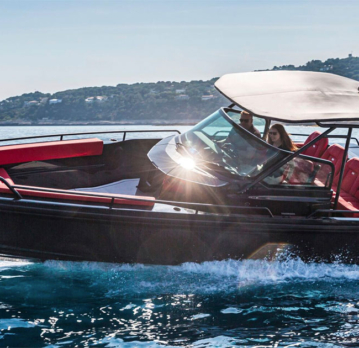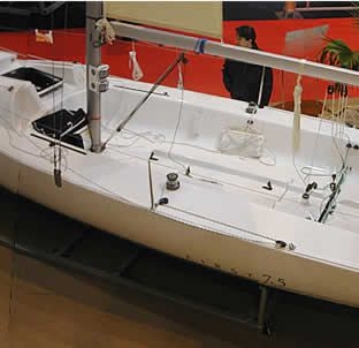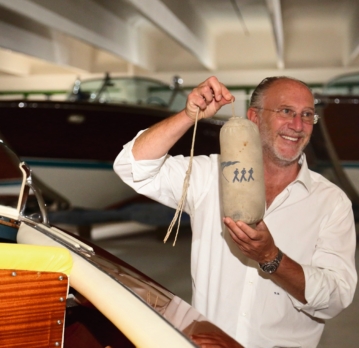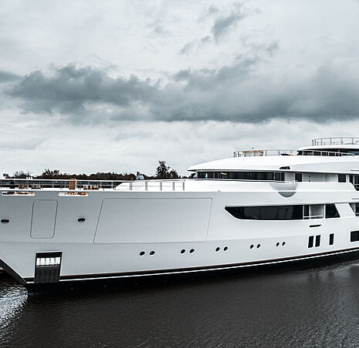July 31, 2019
Legendary Fastnet Race
This Saturday, August 3, the famous Fastnet Race starts. We bring to your attention an abridged version of Andrey Kirsanov's material about this amazing race, which was published in the August issue of Yacht Russia magazine.


The Rolex Fastnet Race, as its full name sounds, is one of the most complex offshore marine regattas. Every two years, sailors from around the world flock to Cowes Port on the Isle of Wight, where the regatta starts. The distance of 608 nautical miles rounding the Fastnet rock, known as “Tear of Ireland”, was the last piece of land that Irish immigrants saw sailing to America, replete with dangers, including currents, huge waves of the open sea and strong winds.
A bit of background
In the first half of the twentieth century, only the Newport-Bermuda Race, founded in 1904 by the editor of Rudder Thomas Fleming Day, and the Dublin Bay-Cork Harbor race that originated from 1860, existed in the first half of the twentieth century. The race from California across the Pacific to Hawaii was also organized in 1906, but it did not receive due attention from European yachtsmen as it passed in warm waters, far from the true, according to the Old World, ocean waters of the Atlantic. Finally, at the turn of the century, several transatlantic races were held in which huge yachts competed with professional teams.
In general, the yachting community of the southern coast of Great Britain and the Isle of Wight initially had a great deal of skepticism about conducting ocean regattas in the cold waters of the East Atlantic. It was believed that modern yachts for such races are not suitable.
Of course, there were those who thought differently, and among them was George Martin, who since 1905 was a member of the Royal Cruising Club (RCC). His word had weight, because Martin was twice, in 1907 and 1908, awarded the main prize of the RCC – the challenge cup The Challenge Cup. The cup was awarded for its voyages on a 35-ton gaeffle cutter Chance built in 1903: the first was from the Devon coast to Gibraltar and back; the second is around Denmark, during which the crew visited the ports of Norway, Sweden and Germany.
So, according to George Martin, the Royal Cruising Club is simply obliged to become the organizer of a truly ocean racing. However, his ideas were met with harsh resistance even from teammates. 129 members of the club spoke against the organization of the new offshore regatta, only 49 were in favor.
Frustrated by the vote, George Martin left the ranks of the Royal Cruising Club, but, of course, not sailing. By 1923, he had said goodbye to Chance for the sake of the new cutter Jolie Brise. Built in 1913, this elegant yacht was one of the fastest pilot bots in the Norman port of Le Havre, but was "fired from service" under the pressure of steam brothers. This vessel was destined to play a key role in the birth of the Fastnet Race.
George Martin was not going to give up his ideas, little by little recruiting supporters of the organization of the 600-mile ocean race with the start in the Solent and the finish in Plymouth. And then he had a very active ally …
In the years 1922-1924, the Englishman Weston Martyr participated in the Bermuda Race. Despite the fact that the navigational error in the 1924 regatta left Martir’s crew in last place, inspired by sports excitement and the very spirit of competition, he was full of enthusiasm and optimism and, upon returning to his homeland, began to bombard the UK yacht magazines with proposals to hold a similar race in the waters of the North Atlantic. Martir wrote: “This is, without question, the finest sport a gentleman can be involved in, because in order to play this game, you must have the hallmarks of a true athlete: skill, courage and endurance.”
Beginning of the legend
The offer of Weston Martyr was warmly supported by British yacht magazines, and among them – Yachting Monthly and Yachting World … By the beginning of 1925, the movement in favor of a new ocean regatta gained momentum, and it could not be stopped. Exactly then
George Martin, Weston Martyr, and Yachting Monthly Editor Madeleine Hextall-Smith formed the Race Committee, which first decided on the route: Solent Strait – Fastnet Rock – Plymouth. On March 7, 1925, a notice appeared in the pages of The Morning Post that “the regatta will be held under the banner of the Royal Western Yacht Club”.
Four crews showed up for the race in a month, and by the first of July the list of potential participants increased to 14 pennants, including one team from the USA. And yet, on August 15, only seven crews started, and the Irishman Harry Donegan, speaking on the 18-ton Gull, was the only one who slightly diluted the British line-up. It is worth noting, however, that at that time the British yacht establishment (and not only the yachting) considered the question of creating an independent Irish state just a “temporary delusion”. Nevertheless, the regatta, in fact, has become international …
The first Fastnet race turned out to be classic in terms of results: fast boats made a rapid breakthrough and successfully reached the finish line in Plymouth, while slower sailboats collided with gusty winds and rough seas. As a result, two boats withdrew from the race, and one could not reach the finish line in the allotted time – the timekeeper judges had already gone home.
The yacht of Harry Donegan had more modern lines than other boats of the regatta, and for some time the Gull headed the fleet. She first passed the Isles of Scilly, but then Mars-Fal was damaged, the speed fell and the lead captured George Martin's Jolie Brise.
On the way back to Plymouth with a fresh south-westerly wind on August 20, Donegan wrote in his logbook: “The folding table in the mess room does everything to kill me. I received a blow to the chest and chin, while the weighty box tried in every way to cut off one or both of my legs. ”
But all this was nothing compared to the main task – to catch up with Jolie Brise. There were chances, but the mistake made by the Gull team in conditions of poor visibility, took the yacht north of Land's End, a rocky cape in the south-west of Great Britain.
The winner of the first Fastnet was the crew of Jolie Brise with a time of 6 days 14 hours and 45 minutes. The second was a 38-foot cutter Fulmar, the third came Gull.
Looking ahead, let's say that Jolie Brise won the Fastnet Race in 1929 and 1930, and that this boat is still afloat, takes part in the regattas, and in 2000 won the overall standings in the Tall Ships Race.
New club
It was during the first Fastnet race that George Martin announced the creation of the Ocean Racing Club, as well as holding the sailors to taste the regatta next year. Indeed, the race proved to be an exciting competition, and besides, it was possible to participate in it by a small crew or even alone.
In his message to Weston Martier on November 12, 1925, Harry Donegan admitted: “I am delighted with this race and am pleased to receive your letter that breathes the sea. And let me say that if my team impressed you, then hardly more than this competition is on us. I am impressed by how high the class of yachtsmen who share the ideas of the Ocean Cruising Club, which means that the regatta has a future. ”
Note that, despite the undoubted success of the regatta, there were yachtsmen, still opposed to this race, and yet there were more and more supporters. And among these enthusiasts there was a man who decided to build a yacht specifically with an eye to this regatta. The Scotsman Norman Bucksendale ordered William Fyve III to build a Bermuda-style cutter that would comply with the new Ocean Racing Club rules – 70 feet in length, 50 feet on the waterline. On the drawing boards, and then on the stocks, work began to boil. The new sailboat was given the name Hallowe’en.
A second time
Of course, there were those who, once taking part in the Fastnet race, no longer intended to re-engage in this adventure, but there were also those who considered it mandatory for themselves. And among these "stubborn" was Harry Donegan, who declared his indispensable participation in the 1926 regatta.
Eight yachts took part in the second Fastnet Race. Despite the strong, convenient for her wind, Hallowe’en was at the finish line first with a margin of only 10 hours, setting a record for this distance, which lasted until 1939. By that time, the organizers of the regatta were allowed to participate larger sailboats, so this was to be expected. The new record time belonged to the 88-foot Iol Nordwind, which was managed by the German crew, and it should be noted that the German yachtsmen did not endear the organizers of the regatta to their strange appearance and behavior: they were dressed in military uniform, and at the presentation ceremony threw their hands in Hitler's greetings. If we proceed from the size of the yacht, then until 1971, no one could break the Hallowe’en record until Ted Turner's yacht with the patriotic name American Eagle was launched.
Leaders and participants
Organizing Fastnet every year, as it was supposed, was still beyond the power of the organizers, and since 1931 the regatta began to be held every two years, eventually becoming a kind of qualification minimum for yachtsmen-circumnavigators.
If you look at the first 15 regattas, from 1925 to 1953, the statistics are implacable: the British confidently held the championship in it – 10 victories. The Americans won four times (noteworthy that three of these victories were won on yachts designed by Sparkman & Stephens). Only one victory for this period went to the Dutch yachtsmen who performed in 1937 on the Zeearend sailboat.
By the 1970s, the popularity of the regatta became incredible after grants such as Francis Chichester, Robin Knox-Johnston and even … the leader of the conservative party, Edward Heath, who in the 1969 race aboard the Morning Cloud began to take part in it seventh in its class.
In 1973, the International Offshore Rule was introduced, and in the same year teams and boats received permission for sponsorship.
Tragedy of 1979
Black days may come for each race. In August 1979, the pages of newspapers and magazines, even those far from yachting, were full of gloomy headlines: "Racing with death," "There could be more deaths," "Is it only the element that is to blame?" In reports from the scene, in interviews with officials, the circumstances and reasons for the tragedy that took place during the next Fastnet race were discussed.
On Saturday, August 11, with a 3-4-point west wind, a fleet of 306 yachts launched in the port of Kausa. At intervals of 10 minutes, boats of seven different classes went to a distance. On Saturday and Sunday, the fleet advanced along the south coast of Great Britain with weak west winds and poor visibility. Nothing foreshadowed further deterioration of the weather. When the weather stations broadcast a forecast on Monday night that promised to increase the wind up to 5-6 points, most of the participants in the regatta were even happy about this.
Almost simultaneously with the start of the regatta far from Kaus – on the shores of Canada – a cyclone was born that began its movement across the North Atlantic at a speed of about 1000 miles per day. Approaching the shores of Ireland, the warm air masses that came from the west coast of the Atlantic, faced with a cold front coming from Iceland. In a short period of time, the pressure in the center of the cyclone fell to 979 mbar, the cyclone’s motion path sharply deviated from the route outlined by weather forecasters to the north, and the cyclone passed over the very center of the Irish Sea – between the Scilly Archipelago and the Fastnet rock. Needless to say, by the beginning of the storm, the bulk of the yachts were here …
The officer on duty at the Royal Navy rescue station in Caldrose – on the Cornwall Peninsula, while on a short watch, at 1:40 he heard an alarming voice weakened by distance and noise: “Maidai!” The crew of the yacht with a broken steering wheel asked for urgent help: waves tore off the manhole cover.
Soon, distress signals began to come one after another, calls for help filled the air. They were mostly served from yachts that had not yet reached the Fastnet cliff and were located to the North West from Scilly, at a distance of 15 to 100 miles from Cape Lizard.
Here is the result: sixty-nine yachts did not finish, twenty-four were left by the crew, five sank, 15 yachtsmen died. The 1979 Fastnet drama was the largest tragedy in the history of modern sailing.
People from
The struggle of two sea nations, the British and the French, was fully manifested in the waters of the Irish Sea.
The first French victory in Fastnet was brought in 1967 by none other than Eric Tabarley on the Duick III, a 17-meter aluminum yacht designed by himself. In the same year, he won the Sydney – Hobart regatta on this boat.
After that, luck turned away from the French over and over again until, in 1999, Whirlpool-Europe 2 under Catherine Shabau ranked first at the finish. In 2005, the Fastnet winner for the adjusted time was the French crew of Jean-Yves Chateau at Iromiguy.
In 2013, the French again triumphed, they won in the following seasons – in 2015 and 2017.
In 2001 the Swiss watch company Rolex became the official sponsor of Fastnet. The name of the sponsor was added to the official name of the regatta, it became known as the Rolex Fastnet Race.
In 2013, the list of applications for participation Fastnet was filled within 24 hours from the date of its opening. (In recent years, in order to apply, you need to meet five minutes.) That year, the list of participants turned out to be a record number – 12 – crews from Russia. In general, for the almost century-long history of the race, Russian crews took part in it more than once. So, in 1997 and 1999 it was the Ivan catamaran (moreover, it won in its class). Another regular participant is the St. Petersburg yacht "Anna". The team of the Russian club of offshore races SeaVentus participated in the race several times.
In general, throughout the history of the famous race, the British won 17 times, while the French managed to come first six times, but the trend emerging over the last three races promises to add a regatta of fire in 2019. And yet, it remains only to guess who will be the strongest this year: again the French, the British … or maybe someone else?
236 July 31, 2019 # 9321
Chief Editor
fastnetlegendaryrace













What do you think?